For the 2025 school year, there are 4 public schools serving 1,942 students in Social Circle City School District. This district's average testing ranking is 7/10, which is in the top 50% of public schools in Georgia.
Public Schools in Social Circle City School District have an average math proficiency score of 36% (versus the Georgia public school average of 38%), and reading proficiency score of 42% (versus the 40% statewide average).
Minority enrollment is 30% of the student body (majority Black), which is less than the Georgia public school average of 65% (majority Black).
Overview
This School District
This State (GA)
# Schools
4 Schools
2,330 Schools
# Students
1,942 Students
1,747,653 Students
# Teachers
136 Teachers
121,051 Teachers
Student : Teacher Ratio
14:1
14:1
District Rank
Social Circle City School District, which is ranked within the top 50% of all 222 school districts in Georgia (based off of combined math and reading proficiency testing data) for the 2021-2022 school year.
The school district's graduation rate of 90-94% has decreased from 95% over five school years.
Overall District Rank
#74 out of 222 school districts
(Top 50%)
(Top 50%)
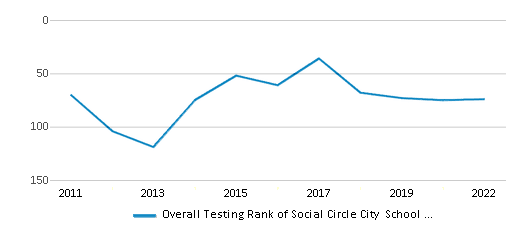
Math Test Scores (% Proficient)
36%
37%
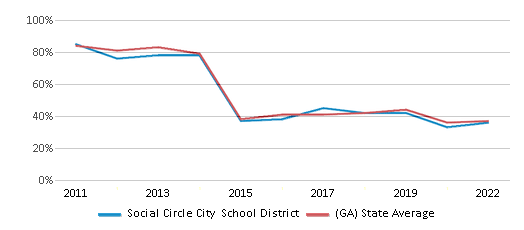
Reading/Language Arts Test Scores (% Proficient)
42%
40%
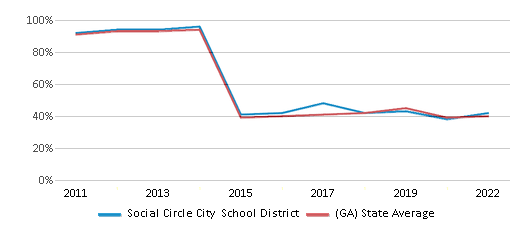
Science Test Scores (% Proficient)
31%
40%
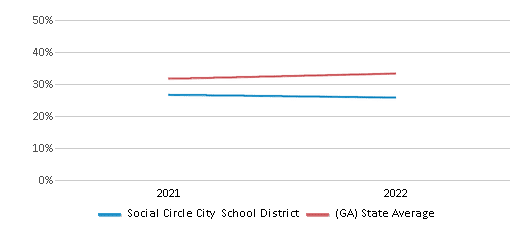
Graduation Rate
90-94%
84%
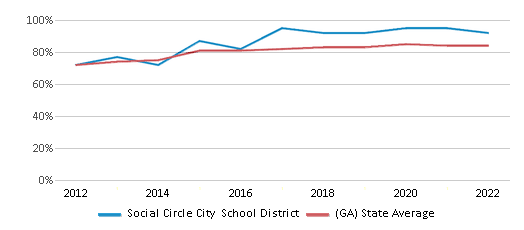
Students by Ethnicity:
Diversity Score
0.47
0.71
# American Indian Students
1 Student
3,918 Students
% American Indian Students
n/a
n/a
# Asian Students
18 Students
85,795 Students
% Asian Students
1%
5%
# Hispanic Students
94 Students
327,122 Students
% Hispanic Students
5%
19%
# Black Students
394 Students
632,133 Students
% Black Students
20%
36%
# White Students
1,354 Students
612,293 Students
% White Students
70%
35%
# Hawaiian Students
n/a
1,734 Students
% Hawaiian Students
n/a
n/a
# Two or more races Students
81 Students
84,151 Students
% of Two or more races Students
4%
5%
Students by Grade:
# Students in PK Grade:
94
50,489
# Students in K Grade:
138
118,882
# Students in 1st Grade:
137
124,992
# Students in 2nd Grade:
123
128,523
# Students in 3rd Grade:
143
125,808
# Students in 4th Grade:
149
127,364
# Students in 5th Grade:
131
128,693
# Students in 6th Grade:
142
129,323
# Students in 7th Grade:
145
131,446
# Students in 8th Grade:
161
133,602
# Students in 9th Grade:
166
153,942
# Students in 10th Grade:
155
144,127
# Students in 11th Grade:
134
131,171
# Students in 12th Grade:
124
119,291
# Ungraded Students:
-
-
District Revenue and Spending
The revenue/student of $10,667 in this school district is less than the state median of $14,305. The school district revenue/student has stayed relatively flat over four school years.
The school district's spending/student of $11,329 is less than the state median of $13,431. The school district spending/student has stayed relatively flat over four school years.
Total Revenue
$21 MM
$24,999 MM

Spending
$22 MM
$23,473 MM
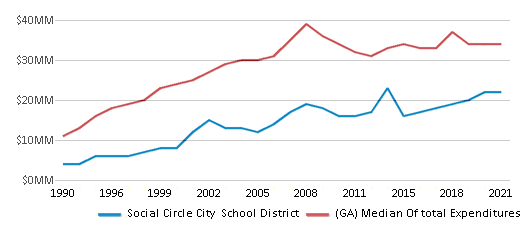
Revenue / Student
$10,667
$14,305

Spending / Student
$11,329
$13,431
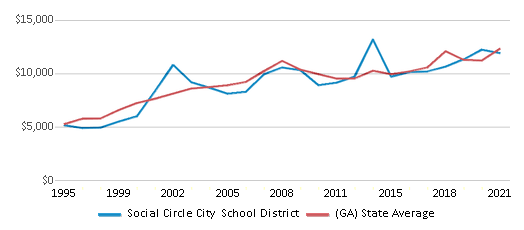
Best Social Circle City School District Public Schools (2025)
School
(Math and Reading Proficiency)
(Math and Reading Proficiency)
Location
Grades
Students
Rank: #11.
Social Circle Elementary School
(Math: 48% | Reading: 46%)
Rank:
Rank:
8/
Top 30%10
240a W Hightower Trl
Social Circle, GA 30025
(770) 464-2664
Social Circle, GA 30025
(770) 464-2664
Grades: 3-5
| 423 students
Rank: #22.
Social Circle High School
(Math: 25-29% | Reading: 50-54%)
Rank:
Rank:
7/
Top 50%10
154 Alcova Dr
Social Circle, GA 30025
(770) 464-2611
Social Circle, GA 30025
(770) 464-2611
Grades: 9-12
| 579 students
Rank: #33.
Social Circle Middle School
(Math: 30% | Reading: 36%)
Rank:
Rank:
5/
Bottom 50%10
154 Alcova Dr
Social Circle, GA 30025
(770) 464-1932
Social Circle, GA 30025
(770) 464-1932
Grades: 6-8
| 448 students
Rank: n/an/a
439 Annie P Henderson Dr
Social Circle, GA 30025
(770) 464-1411
Social Circle, GA 30025
(770) 464-1411
Grades: PK-2
| 492 students
Frequently Asked Questions
How many schools belong to Social Circle City School District?
Social Circle City School District manages 4 public schools serving 1,942 students.
What is the rank of Social Circle City School District?
Social Circle City School District is ranked #74 out of 222 school districts in Georgia (top 50%) based off of combined math and reading proficiency testing data for the 2021-2022 school year.
What is the racial composition of students in Social Circle City School District?
70% of Social Circle City School District students are White, 20% of students are Black, 5% of students are Hispanic, 4% of students are Two or more races, and 1% of students are Asian.
What is the student/teacher ratio of Social Circle City School District?
Social Circle City School District has a student/teacher ratio of 14:1, which is equal to the Georgia state average of 14:1.
What is Social Circle City School District's spending/student ratio?
The school district's spending/student of $11,329 is less than the state median of $13,431. The school district spending/student has stayed relatively flat over four school years.
Recent Articles
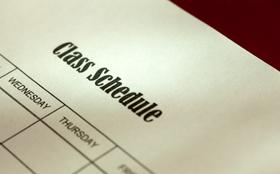
Year-Round Or Traditional Schedule?
Which is more appropriate for your child? A year-round attendance schedule or traditional schedule? We look at the pros and cons.

Why You Should Encourage Your Child to Join a Sports Team
Participating in team sports has a great many benefits for children, there is no doubt. In this article you will learn what those benefits are.

White Students are Now the Minority in U.S. Public Schools
Increasing birth rates among immigrant families from Asia and Central and South America, combined with lower birth rates among white families, means that for the first time in history, public school students in the United States are majority-minority. This shift in demographics poses difficulties for schools as they work to accommodate children of varying language abilities and socio-economic backgrounds.





